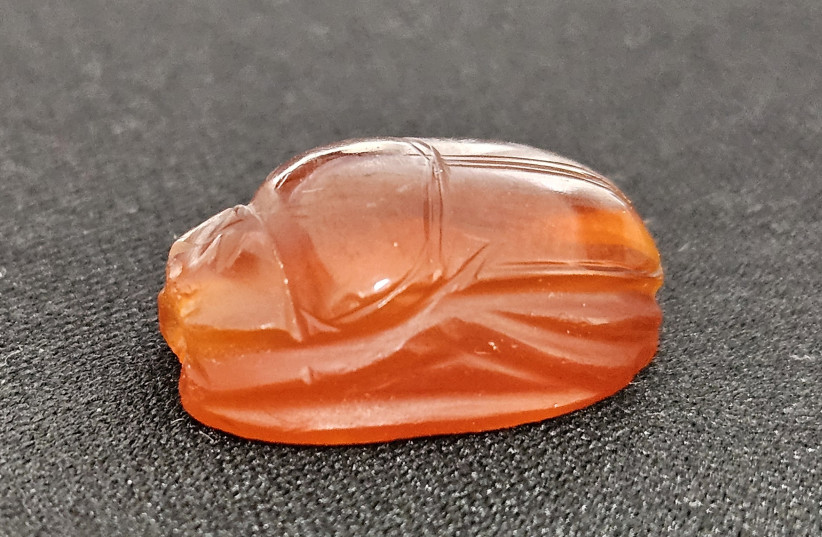A scarab amulet dating from the time of the First Temple and used by an Assyrian official was found recently by Erez Abrahamov, 45, of Paduel on a walk in the Nahal Tabor nature reserve in Lower Galilee. It may have been used by an Assyrian or perhaps Babylonian official almost 2,800 years ago, at the time of the First Temple. The Assyrians were responsible for the destruction of the Kingdom of Israel.
The rare find was transferred to the Israel Antiquities Authority (IAA) as required by law, and Abrahamov received a certificate of appreciation for his efforts.
“I went on a two-day leave from the IDF reserves and decided to take advantage of the two sunny days for a hike,” Abrahamov recalled. “I saw something shimmering peeking out of the ground. At first, I thought it was a bead or an orange stone, but after I picked it up, I noticed that it had engravings that resembled a beetle. I called and reported the amazing find to the IAA.”
Nir Distelfeld, the inspector of the authority’s robbery-prevention unit, said that he received a call from Abrahamov and realized that he had found something special. “I told him to take a good look at the other side – the flat side of the scarab he found and check if there is any engraving on it. I heard him issue exclamations of admiration on the phone, and he reported to me that he recognized a figure.”
He added: “We thank Erez, who demonstrated good citizenship and handed over the rare scarab to us for studying and preserving. Such a rare find can certainly expand our knowledge of the past. The beautiful scarab was found at the foot of Tel Rekhesh, one of the most important tels (mounds) in northern Israel. The site is identified in the research with the city of Anharat (Book of Joshua: 19:19) within the territory of the tribe of Issachar.”

Similar scarabs have been dated to the 8th century BCE
According to Prof.-Emeritus Othmer Kiel from the University of Fribourg in Switzerland: “On the scarab, made of a semi-precious stone called carnelian – a semi-precious, translucent variety of the silica mineral chalcedony that gets its red-to-reddish color to iron oxide – is a mythological animal called a griffon or a galloping winged. Similar scarabs have been dated to the 8th century BCE.”
According to Dr. Itzik Paz, an IAA archaeologist who has excavated at Tel Rekhesh, one of the most important remains there dates back to the Iron Age (6th to 7th centuries BCE).
“During this period, a large citadel that belonged to the Assyrians stood at the top of the mound, where plastered bathing facilities, halls, and ceremonial rooms were found.
“The scarab is a type of seal that was widely used throughout the ancient world from the 4th millennium BCE onwards. The scarab seals were shaped like a dung beetle, hence their name. The name in Egyptian is derived from the verb ‘to be made’ or ‘to be created,’ and this is because the Egyptians considered a scarab to be a symbol of the incarnation of God the Creator.
“The griffon on the scarab just found is a well-known artistic motif of the ancient Near East, and is common on seals from the Iron Age. In light of the paucity of findings that have been discovered within the citadel so far, and if indeed the seal can be dated, based on artistic aspects of the late Iron Age, we may be able to link the seal to an Assyrian presence in the citadel of Tel Rekhesh, which would be a discovery of great significance,” said Paz.
“The scarabs were fashioned from a wide variety of stones, including semi-precious stones such as amethyst and carnelian, but most scarabs were made from steatite – a soft talc stone with a grayish-green or brown color, usually covered with a blue-green glaze. The glaze survived only in the dry climate of Egypt, therefore in the scarabs discovered here, it’s almost impossible to find remains of glaze and the color of the original stone color, so it looks grayish-whitish. Against this background, the orange color of the scarab stands out.”
According to IAA director Eli Escuzido, “Like every winter, with the arrival of the rainy season, antiquities begin to ‘float’ and rise above the surface. I ask the public to obey the Israel Antiquities Law – that if you come across an archaeological find, report it to us from the field. The exact location of the find of the object is extremely important so we can learn a lot about it.”
